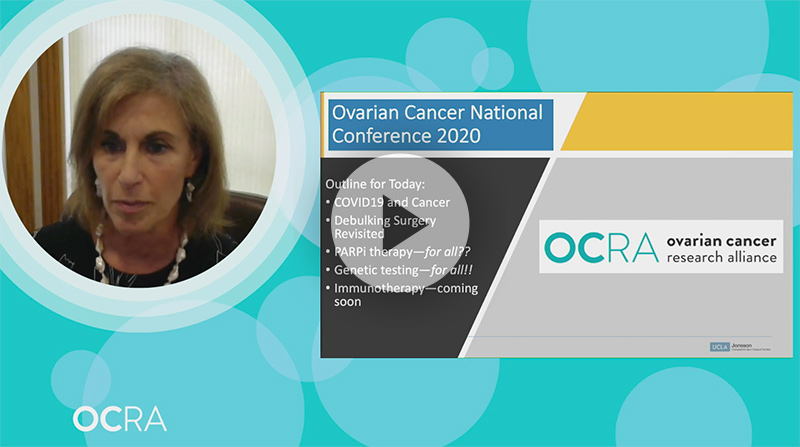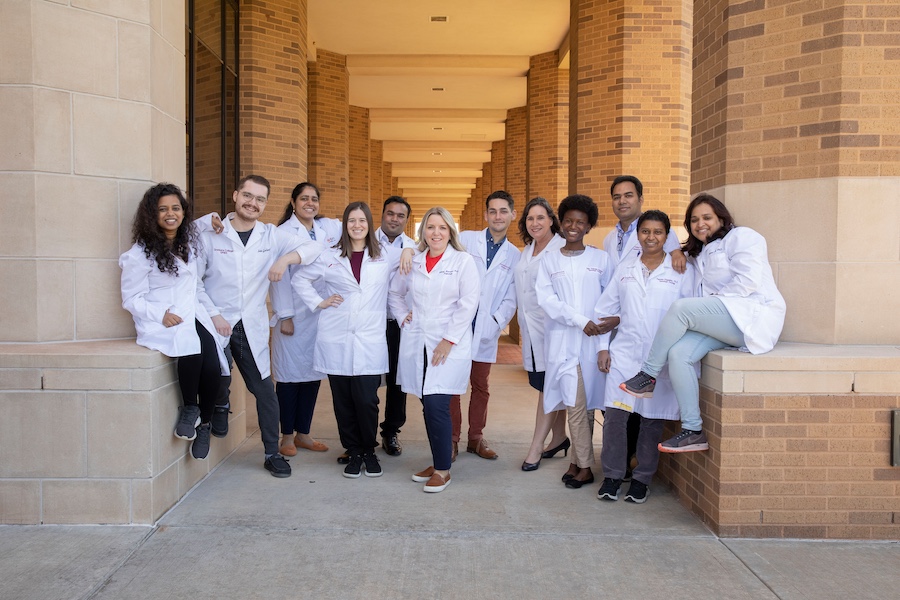
A bright spot in 2020 for the ovarian cancer community has been the ongoing developments in research and treatments. Advances continue to be made, as researchers study the effectiveness of PARP inhibitors as maintenance therapy for ovarian cancer, the most effective way to implement immunotherapy agents, the key factors that can affect the success of secondary debulking surgery, and the benefits of using hyperthermic intraperitoneal chemotherapy.
Read on to learn more about these findings, which were presented at our virtual Ovarian Cancer National Conference by OCRA’s Scientific Advisory Committee Chair Dr. Beth Y. Karlan of the David Geffen School of Medicine, University of California Los Angeles (UCLA).
New findings on PARP inhibitors and ovarian cancer
- The use of PARP inhibitors as maintenance therapy for ovarian cancer continues to show promise. The SOLO-1 trial, for instance, illustrates that the PARP inhibitor olaparib can significantly improve progression-free survival for patients with an inherited BRCA mutation. In this study, 60.4% of the patients who took olaparib as maintenance therapy after upfront platinum-based chemotherapy were still without evidence of disease at three years. “Maybe some of those women who are still without any disease at five years…maybe it will go on like that for 10 years or maybe they’ll be cured,” Dr. Karlan said. “We’re still waiting for the overall survival… but this, I think, really shook our world.”
- Other findings show that PARP inhibitors may also be effective in patients who do not have an inherited BRCA mutation but do have a DNA repair deficiency present in their cancerous cells. “Those are trials that are ongoing and some of the early data show indeed [that] PARP inhibitors can help in many of those situations… so knowing your genetics is vitally important,” Dr. Karlan noted.
Improvements in immunotherapy for ovarian cancer
- Research into immunotherapy continues to advance, as scientists explore new ways to improve its efficacy as an ovarian cancer treatment. A recent Phase II trial conducted by OCRA grantee Dr. Dmitriy Zamarin and co-researchers found that combining the checkpoint inhibitors ipilimumab and nivolumab resulted in a response rate of 31.4% as compared with just 12.2% for those patients using nivolumab alone. “It appeared to really have most significant benefit in patients with clear cell tumors and should be something that should be considered in those women to provide them with longer survival,” Dr. Karlan said.
Secondary debulking surgery and HIPEC survival rates
- New research points to improved survival rate for patients who undergo secondary debulking surgery to treat recurrent ovarian cancer if all the tumor is removed. The patients who will most benefit are those who have completed their chemotherapy a minimum of one year prior and who have less than three sites of disease. When complete removal of visible disease is achieved through secondary debulking surgery, the overall survival rate is more than five years, as compared to less than four years with no surgery. “Like with primary debulking surgery, you need to get out all the tumor,” noted Dr. Karlan. “And so patient selection is key but also the team that you have with your physician, with your doctors, gynecologic oncologist and surgeon is also key.”
- A recently published study shows that the use of hyperthermic intraperitoneal chemotherapy (HIPEC) immediately after debulking surgery can improve survival rates for stage III epithelial ovarian cancer patients. The likelihood of surviving more than five years increases to about 50% with this type of treatment as compared with less than 30% without it. “What they are learning about more and more is that the microenvironment where the tumor cells live can really be influenced and really prime it to not be able to come back. And that’s what is being done here,” explained Dr. Karlan.
OCRA remains committed to supporting the research that made these breakthroughs possible and furthering the learnings of the scientists studying this disease. Stay updated on the latest developments in ovarian cancer research by checking our website regularly and following OCRA on Facebook, Twitter, Instagram and LinkedIn.

Watch now: “What’s New in Ovarian Cancer Research and Treatment,” and other informational videos originally presented at our National Conference are now available in their entirety on our website. View all ovarian cancer videos.


